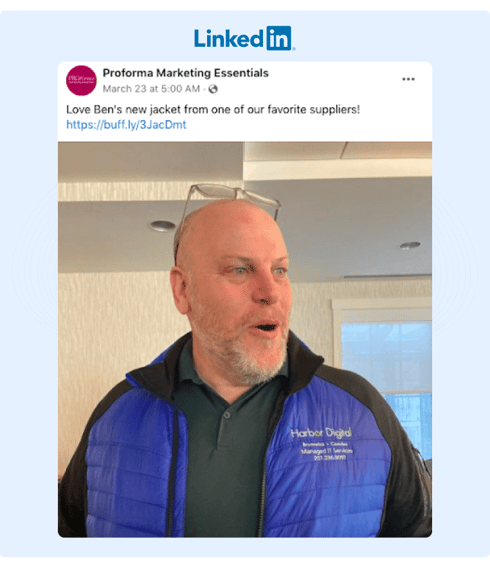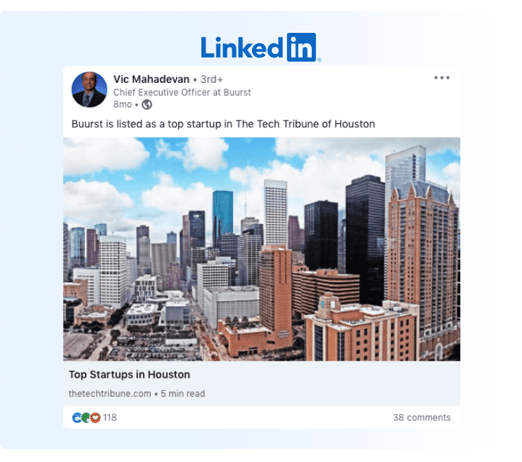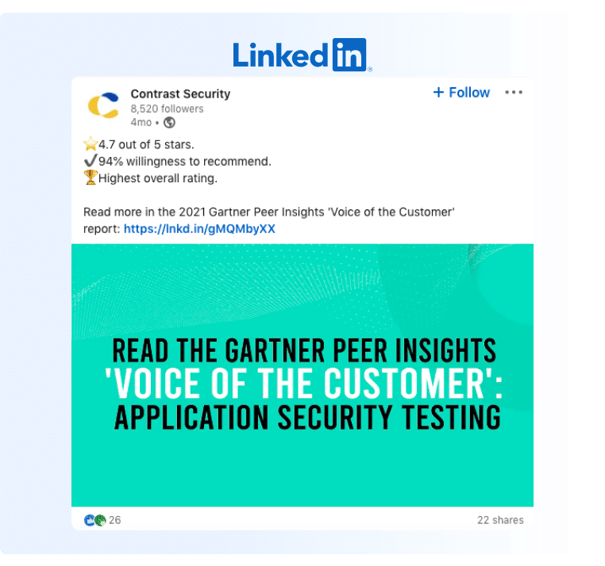How to Get Social Media Buy-In Across Your Organization
Most executives agree that their target audience is somewhere on social media. In fact, half of all U.S. adults with college degrees have at least a Linkedin profile.
However, executives tend to be skeptical of social media because:
-
People typically don’t trust branded content as much as personal content.
-
Social algorithms provide limited reach to branded social media content because they want companies to pay for ads.
If you pull up the average big B2B brand’s social media account, you’ll see that most have very little engagement.
Therefore, your executives probably interpret that as a sign that social media doesn’t work for B2B brands. However, we’ll give you the proof below to show them that this is actually an opportunity.
The key to a successful B2B social media strategy is actually leveraging your employees to engage with prospects for you.
Specifically, we’ll show you real examples of how B2B brands effectively leverage employee advocacy across social media to:
-
Drive more revenue
-
Lower CPC costs
-
Increase sales pipeline
-
Generate quality brand awareness
-
Drive website traffic
-
Attract top talent
You can use this post as leverage to earn social media buy-in from executives by:
-
Acknowledging that most B2B brands don’t execute social media strategies effectively and articulate why.
-
Presenting a new approach to social media that uses employee networks.
-
Solidifying the argument with various case studies that prove a well-executed B2B social media strategy can drive revenue, lower CPC costs, etc.
What is Social Media Buy-in?
Social media buy-in is winning approval from executives to invest more in social media marketing. To do this, you’ll have to prove that social media is an effective channel to drive valuable brand awareness and conversions.
Therefore, here’s a behind-the-scenes look at some of the top-performing B2B social media strategies.
The Secret Top B2B Brands Use to Win On Social Media
Top performing B2B brands understand two critical concepts:
-
People typically trust other people more than brands.
-
Social media algorithms limit the reach of branded content as they want brands to pay for ads.
At this point, you probably think that social media is a waste of time for B2B brands. If the strategy is just posting promotions and blog article links to your brand's social media pages, you're right – it won't produce stellar results.
However, all of the case studies below approach social media very differently.
Specifically, they leverage their employee's networks.
This works really well because:
-
Each individual employee likely has a network of followers that aren't following your company page.
-
Personal pages statistically have more reach than brand pages' organic reach.
-
People trust content from friends and colleagues more than branded content.
Therefore, let's jump into a few examples of how B2B brands effectively use social media to drive real business results.
Examples That Prove The Value of an Organic B2B Social Media Strategy
Here are just a few examples of how social media drives impactful business results.
Example #1: How Social Media Can Drive Revenue
If your executives are skeptical about investing in social media, Proforma Marketing Essentials is an excellent example of a company that effectively uses social media to drive more revenue.
In fact, their social media strategy drove over $5,000,000 in sales.
So how did they do it?
Their Director of eCommerce, who had taken over the social media strategy, created content designed to authentically engage with their target audience. For example, rather than just sharing a blog post or promoting a sale, they consistently post customers showing off the product in a fun and engaging manner.
Notice that this doesn't look like the typical B2B social post – it looks like a post that a friend might create:
However, these posts alone weren't generating the engagement they needed. To supercharge their growth, they implemented an employee advocacy strategy.
Specifically, Proforma launched a four-week social media sales challenge in which 15 franchise owners participated.
Their director of eCommerce Solutions led the initiative and used GaggleAMP to tell each franchise owner:
-
Which posts to share/engage with (and even what to say for each engagement)
-
When to share/engage with that post (they could set it to automatically publish at a specific time)
This strategy drove 242 new leads and 19 booked appointments in just four weeks. Ultimately, they have driven $5,000,000 in revenue from this strategy since implementation.
Example #2: Lower CPC Costs
If you're currently running social media ads, show your executives how an effective organic social media strategy can lower CPC costs.
Data pipeline solution, Buurst, adopted an organic social media strategy that enabled them to save $20,000 in ad spend over four months.
They approached social media by creating unique content and then asked employees to share it on their personal social media profiles.
They previously spent about $50,000 on Linkedin and Google ads over six months. Though after seeing their new social media strategy take off, they eventually turned off those ads and switched to only using social media.
In total, Buurst generated over 700 high-quality clicks using their new social media strategy. If they had to pay for those clicks from Linkedin or Google Ads, it would have cost them over $20,000.
It's also worth noting that they only have a team of roughly 20 employees, so you don't have to have a massive corporation to make an employee advocacy social media approach work.
If you want to execute a similar strategy, you can use the same employee advocacy platform they used, GaggleAMP.
Example #3: Increase Sales Pipeline
Showing executives that social media can increase your sales pipeline is an easy way to get more social media buy-in.
WGroup, a Wavestone company, is a perfect example of how a strong social media strategy can increase sales pipeline through social selling. They have roughly 100 employees and serve Fortune 1,000 companies, so getting in front of the right people in these companies is critical.
In just three years, they have driven over $2 million in sales pipeline from social media. It's also driven significant brand awareness, garnering over 7.8 million impressions and 7,300 clicks to the content.
They created a social media strategy that used a third-party marketing agency to interview consultants and then create content based on those interviews that reflected the consultant’s insight and knowledge.
Despite the quality of the content, WGroup knew that if they simply posted links to these articles on social media, it wouldn't gain much traction.
Instead, they asked employees to share and engage with the content on their personal social media accounts.
Example #4: Generate Quality Brand Awareness
Executives know that a strong brand will ultimately have a much better advantage over newer brands nobody knows. So even though brand awareness might not result in immediate sales, it's incredibly powerful and will help the company win in the long run.
Fortunately, a strong social media presence is one of the best ways to generate brand awareness, and SendGrid was a perfect example. Here is a brief snapshot of their social media KPIs five months after implementing a documented social media process:
But it wasn't just a matter of just sharing content on social media.
Prior to their acquisition by Twilio, this email marketing firm approached social media marketing by starting with excellent, high-quality, professional videos that highlight key use cases for the product and post natively to each social media platform.
As they have hundreds of employees, they knew that employee advocacy would be an effective solution to get the content in front of more people. Unfortunately, their original efforts of manually asking employees via Slack to like or share the content ultimately failed.
Employees didn't know what to say when commenting and sharing as they didn't want to write anything that didn't align with the brand image. Additionally, there was no way of tracking which employees did and did not engage.
To combat this issue, they adopted (before their acquisition) an employee advocacy platform (GaggleAMP) that enabled the Social Media Coordinator to assign specific posts to specific employees and even provide ideas for marketing-approved comments. As a result, their social media engagement and brand awareness went through the roof.
Example #5: Drive High Quality Website Traffic
B2B businesses typically turn to SEO and paid advertising to generate more traffic, though top performing B2B social media strategies are also incredibly effective at driving quality traffic.
Contrast Security is one of those companies.
Their approach to social media is relatively simple:
Create unique social media posts for each new content asset, media reference, or event.
This means they publish between four to six new social posts each business day across four different social media channels. They realize that not all of their followers see every post, so increasing the volume of posts also increases reach.
In addition, it's relatively easy to create these social posts as it's basically repurposing existing content.
However, that's only the foundation of their social media strategy.
The real magic that helped them amplify reach was incorporating an employee advocacy program. They used GaggleAMP to assign their employees various content to engage with and share.
As a result, they generated over 10,000 social interactions and 3,000 clicks during the initial pilot test.
In addition, this traffic was typically higher quality than organic SEO traffic or paid traffic because the employees promoting the posts had already done the heavy lifting of creating a solid relationship with that prospect.
Therefore, it's much easier to convert a prospect coming to your website based on an employee's recommendation than a traditional advertising platform.
Example #6: Attract Top Talent
About 88% of hires are based on employee referrals, though most businesses don't have a solid strategy of leveraging employee networks to make more hires.
However, staffing firm JBC realized that incorporating a structured employee advocacy plan into their social media strategy could improve the number of qualified applicants.
Their process is to assign every new job position to an employee through their employee advocacy platform, GaggleAMP. The employee then either creates a post about the job on their personal social media page or engages with the company's post regarding that job opening.
As a result, JBC has filled numerous job openings from its social media strategy and generated over 8,000 social interactions and 7,600 clicks (over $73,000 in EEMV).
Navigating Roadblocks in Your B2B Social Media Strategy
While employee advocacy is incredibly effective, most brands find executing an employee advocacy strategy is difficult for a few reasons:
-
Employees don't post or engage with branded content as they don't know what to say or do.
-
Following up with employees that didn't engage is difficult as manually tracking engagement across the company is a headache.
-
It doesn't make sense for every employee to share every post – but cherry-picking individual employees to share/engage with certain posts is time-consuming.
To solve this, we created an employee advocacy platform that allows social media/marketing managers to post to various social media platforms and then assign employees specific tasks (share this specific post, comment with this specific phrase on this post, etc.).
This makes it easy for employees to quickly see:
-
Which post to engage with
-
Ideas to comment/share appropriately
-
When to publish the engagement
As a result, employee advocacy strategies using this method are typically much more successful.
Final Thoughts
Most companies don't see significant results from social media.
However, the examples above should be more than enough proof that a well-executed employee advocacy program with a strong social media strategy can still drive excellent results.
If your current plan involves creating thoughtful content and posting organically to each social channel, you're on the right track. Though if you don't amplify that content, the social algorithms will work against you and only a small percentage of your followers will see the content.
To get your social media content in front of more people, incorporate an employee advocacy program.
If you need a platform that makes it easy to assign various posts to employees and then track engagement, consider using GaggleAMP. You can sign up for a demo today, or start a free trial!















